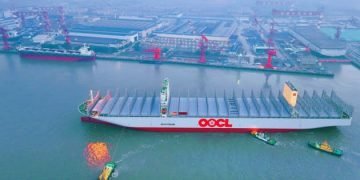By Eva Richardson
March 3, 2025 – In a move that could reshape global maritime trade, the United States Trade Representative (USTR) has proposed imposing hefty fees of up to $1.5 million per vessel on Chinese-built or Chinese-flagged ships entering American ports. This initiative aims to counter China’s dominance in global shipbuilding and bolster the U.S. domestic shipbuilding industry, but it also raises concerns over rising freight rates and potential trade retaliation.
Strategic Trade Measure or Escalation?
The proposal, which will be subject to a public hearing on March 24, 2025, marks one of the most aggressive moves by the U.S. government against Chinese maritime influence. The policy would directly impact global ocean carriers operating through American ports and could increase shipping costs for U.S. importers, retailers, and manufacturers.
According to U.S. officials, these measures are necessary to level the playing field in the shipbuilding sector, where China currently controls nearly 50% of global ship production through heavy state subsidies.
Implications for Global Supply Chains
Industry experts warn that this policy could cause a ripple effect across global trade, increasing operational costs for shipping lines and potentially leading to higher consumer prices.
“This move could force carriers to rethink their route strategies, potentially favoring alternative ports or increasing fees for U.S. imports,” said Mark Davidson, CEO of Global Freight Solutions, in an exclusive interview with The Logistic News.
China’s Expected Response
In reaction to the announcement, China’s Ministry of Commerce has strongly condemned the proposal, warning of potential countermeasures that could include retaliatory tariffs on American exports, restrictions on U.S. cargo entering Chinese ports, or even a shift in global trade routes.
“We are prepared to defend our shipping industry and will take necessary steps to ensure fair and equitable treatment,” said a spokesperson from China’s trade ministry.
Impact on U.S. and International Shippers
For international freight forwarders, the new U.S. policy could lead to:
- Higher transpacific freight rates due to increased operating costs for Chinese carriers.
- Supply chain reconfigurations, with companies looking for alternative ports to avoid heavy fees.
- Potential bottlenecks at U.S. ports if Chinese shipping firms reduce their services.
What’s Next?
The public hearing on March 24 will determine whether this policy moves forward. Meanwhile, industry leaders and trade organizations are lobbying to prevent unnecessary disruptions to global commerce.
As the geopolitical landscape continues to evolve, the world will be watching closely to see how this landmark decision reshapes international shipping and trade relations.
For more exclusive updates on the latest developments in maritime logistics, stay tuned to The Logistic News.






















